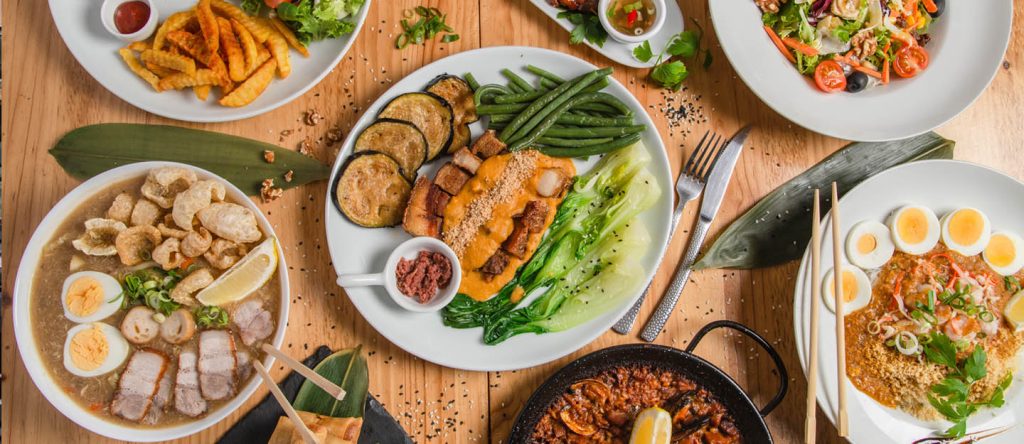If you walk through Al Karama or Satwa around dinner time, you’ll notice something comforting in the air. The sizzling aroma of garlic rice, the savory hum of sinigang broth, and the familiar sound of Tagalog spoken between servers and guests—it all pulls you in. Filipino food in Dubai isn’t niche. It’s vital. It feeds thousands who miss home and introduces thousands more to a cuisine of generosity and depth. The meals are hearty, the portions unshy, and the smiles behind every plate feel just like a cousin’s kitchen.
Karama remains the heart of Filipino dining—and for good reason
Step into Karama during the evening rush, and you’ll find queues forming in front of tiny storefronts glowing with roasted chicken and trays of pancit. This neighborhood didn’t just welcome Filipino cuisine—it embraced it. It’s where many OFWs gather after work, where birthdays are celebrated over lechon kawali, and where tables are rarely for one. In Karama, restaurants don’t need fancy interiors. The food does all the talking. Each dish arrives familiar but fresh, like hearing your favorite old song played slightly differently, and still loving every note.
Late-night cravings are solved in Al Rigga—Filipino kitchens never sleep
When most of Dubai quiets down, Al Rigga lights up with fluorescent signs and the clatter of cutlery in 24-hour eateries. Here, adobo is available at midnight, tapsilog at 3 a.m., and halo-halo after sunrise. It’s the go-to zone for shift workers, night owls, and anyone with a stomach that follows no clock. The vibe is casual but quick, with waiters who remember your face after one visit. If you want bulalo at an odd hour or just need hot sinigang to soften the day’s edges, Rigga understands.
Seafood lovers find comfort in communal meals made for sharing
The Filipino love of communal eating finds its perfect home in Dubai’s seafood grills. Picture banana leaves laid out instead of plates, grilled shrimp piled beside crab claws, and hands—not forks—doing most of the work. These seafood feasts are loud, messy, and joyful. The boodle fight concept is especially popular, offering not just food but fun. There’s no status at these tables—just hunger and laughter. If you’re looking for authenticity that goes beyond the menu, start with grilled squid and end with everyone licking their fingers.
Malls bring Filipino fast food closer, making joy available in five minutes
Sometimes comfort food doesn’t need a tablecloth. It needs speed, spice, and something deep-fried. Jollibee, with its bright red mascot and long queues, delivers that in spades. Chickenjoy, sweet spaghetti, and burger steak feel both playful and personal. In malls like Dubai Mall or BurJuman, these spots aren’t just fast—they’re familiar. They’re where kids beg for a treat, where office workers sneak a quick bite, and where the line between snack and memory blurs. In Dubai, even food courts hold homesickness gently.
Breakfast is sacred in Filipino culture—and Dubai keeps it alive
Filipino breakfasts aren’t shy. They’re bold, salty, meaty, and always served with garlic rice. Luckily, Dubai gets this. Restaurants across Al Satwa and Oud Metha open early, offering silogs that warm you from the inside out. Tapsilog, longsilog, and bangsilog are more than meals—they’re routines. And here, breakfast isn’t rushed. It’s a ritual. You sip hot coffee with condensed milk, unfold a newspaper, and listen to Tagalog pop playing softly overhead. For a few minutes, you’re not in Dubai. You’re back at the family table.

Desserts remind us that sweetness isn’t just a taste—it’s an emotion
Dubai’s Filipino dessert scene is humble but mighty. Halo-halo, leche flan, and ube cakes pop up in bakeries across Al Barsha and Deira. Often, they’re made in small batches by people who learned from memory, not measurements. A spoonful of halo-halo, melting slowly under the sun, can bring back decades. These sweets are nostalgic and new all at once. In this city of skylines, sometimes the richest skyline is a tall glass filled with purple yam, crushed ice, and evaporated milk. A treat that cools the heat, and hearts.
Filipino fusion is rising fast—bold, playful, and ready to surprise
Some restaurants are rewriting the rulebook. You’ll find sinigang ramen, adobo tacos, or ube cheesecake served in sleek cafes with industrial lights. This isn’t dilution—it’s evolution. Younger chefs are reimagining lola’s classics, adding Dubai’s multicultural energy into every bite. Marina and Business Bay are starting to see these spots flourish, attracting not just Filipinos but curious diners across the city. If you thought Filipino cuisine was just comfort food, think again. It’s becoming confident cuisine—and it’s bringing everyone to the table.
Home kitchens and delivery apps bring a bite of the Philippines to your door
In neighborhoods like Discovery Gardens and Al Nahda, home-based cooks prepare trays of lumpia, tubs of kare-kare, and boxes of ensaymada—all ready for pickup or delivery. Social media acts as their storefront, and word-of-mouth is their best review. These aren’t polished businesses—they’re personal lifelines. A nurse bakes on weekends. A driver grills on his balcony. Each dish carries the heart of a home that’s thousands of kilometers away, but still tasted through every bite. Filipino food doesn’t always need a restaurant. Sometimes, it just needs a WhatsApp number.
Festivals and gatherings turn food into celebration, not just sustenance
Attend any Filipino event in Dubai—a karaoke night, an Independence Day picnic, or even a church fundraiser—and food will be at the center. Long buffet tables, styrofoam containers, rice packed into every corner. The food here isn’t plated—it’s piled. It’s about plenty. And in these moments, you see what Filipino cuisine truly means. It’s generosity. You’re always welcome to eat. You’re always asked if you’ve had enough. And you never really have until someone insists you take leftovers home.
Filipino restaurants in Dubai aren’t just places to eat—they’re places to belong
There’s a reason the waiters ask where you’re from. A reason why your second visit feels like your fifth. Filipino eateries in Dubai act like extensions of someone’s home. If you’re far from family, these places become the stand-in. Someone will recommend a dish, smile if you pronounce it right, and bring out extra sauce without being asked. Even if you’re not Filipino, you’ll be treated like you are—for as long as you’re hungry, and even after.
Food connects people—and in Dubai, it connects islands and continents
In a city that moves fast and builds tall, Filipino food brings people back to earth. It’s honest, warm, and full of history. Every meal tells a story of resilience, migration, and celebration. In Dubai, where so many cultures share sidewalks, the Philippines shares its flavors. Whether you’re from Luzon, Visayas, or Mindanao—or just curious to taste something new—this city holds a spoon out to you. All you need to do is take the first bite.


 then "Add to Home Screen"
then "Add to Home Screen"